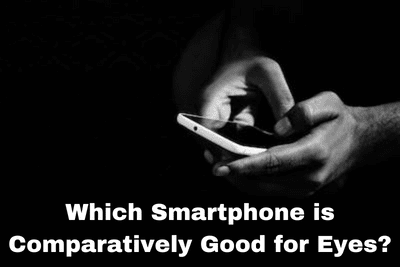Over the past few years, technology has advanced significantly. Which smartphone is comparatively good for eyes? And phones as well. In today’s always-connected world, phones have become an indispensable technology. But eye strain can also result from staring at bright screens all day. Therefore, the focus of this article will be on the mobile device that is best for your eyes. Or, more precisely, what display is most comfortable for your eyes?
It is more challenging than you might think. E-ink is less demanding than other display technologies, but phones using this technology frequently have fewer features. The major flagships from Apple and Samsung, which have LED and OLED displays, have more features. What, then, ought you to do? Let’s investigate.
Which Smartphone Is the Best for Your Eyes?
Let’s start by clearing up one issue. E-ink displays are similar to traditional LCD screens. They do, however, lessen eye fatigue. This is primarily due to two factors. Most phones with E-ink displays feature matte screens—the glossy screen of other, more conventional phone displays. E-ink displays’ matte screens make it possible for your eyes to relax. But there is a small catch. The other problems still need to be addressed. Specifically, viewing angle and blink rate. It will strain your eyes to stare at a screen without blinking, whether on a phone, laptop, or television.
Also Check Out: Is a Projector Better Than TV For The Eyes?
Check Out These Top E-ink Smartphones
Here are the best E-ink phones you can look at before I discuss standard LED and LCD panels. To be clear, these models are not high-end smartphones; they are everyday-use electronics.
Hisense A7
Unquestionably, this is the best E-ink phone currently on the market. The best thing is that the display is in color. The A7 from Hisense has the most “smartphone-like” functionality. It contains a 4770 mAH battery and a 6.7″ big E-ink display. Along with Android 10, you also get 3 RAM options: 4GB, GB, and 8GB. There are also additional features like cameras and compatibility for SD cards.
Onyx Boox Phone
An Octa-core processor will power Android 9 on the Onyx Boox Phone. So not the most recent Android model. not at all, not even close. The phone will include a 5.8″ E-ink display and an SD card slot. It makes the claim that you can watch entire videos in X-mode. Onyx only displayed it during an event, and select reviewers got a sneak peek. Thus, it has yet to be released. But it’s a fantastic choice to keep in mind.
Light Phone 2
Over $2 million was raised for the Light Phone 2 on IndieGogo. Not excellent specs are provided. It sports a Snapdragon Wear 2100 base and 1GB of DDR3 RAM. It is clear from the processor that it is not intended to be a super performer. Due to its extreme minimalism, the Light Phone is only appropriate for a few tasks and occasional light use. On the other hand, E-ink should be less taxing on your eyes.
Also Check Out: Which Display Technology is the Best for Eyes?
How Do LCD and LED Displays Compare?
What about standard phone displays, then? Are they prohibited and harmful to your eyes? Whether a phone has an LCD or a traditional LED display, they are much better today than they were in the past. That is a result of significant advancements in their technology. The refresh rate on newer screens is substantially higher. High-end phone screens can refresh at a rate of 60 to 120 hertz. It follows that LED or LCD screens are now better for your eyes.
Resolution and PPI
Make sure the display is sharp and, more importantly, has a high PPI if you choose an LCD phone. Pixels per inch, or PPI, is precisely what it sounds like. A small display with a shallow resolution is better than a large display with a high resolution. You can check the PPI of the phones you want to purchase using any of the numerous PPI counters available online. PPI ought to be greater than 300.
Technology for Displays and Backlight
If you are interested in smartphones, you may have heard the terms LCD and OLED/AMOLED used frequently. These two display specialists are in demand. To function, LCDs require a constant backlight. OLEDs, however, can produce their light. The diodes can light up and turn off if needed (when displaying black) (when displaying black). So they do not cause that much stress on your eyes. So, what is the takeaway here? Displays with high resolution, PPI, and OLED/AMOLED technology are better if you need a traditional smartphone.
Using your phone without causing eye strain
Whether using a phone with an LCD/OLED display or an E-ink display, it is always a good idea to be aware of basic recommended practices to prevent eye fatigue. Let’s take a quick look at what you can do to minimize eye fatigue. Consider the following a review.
- Apply the 20-20-20 principle. Take a 20-second break every 20 minutes to look at something 20 feet away.
- Utilize your phone in well-lit areas.
- When in darker environments or at night, dim the light.
- One hour before bed, refrain from using your phone or viewing any screens.
- Utilize your phone’s dark mode. It makes the phone’s UI’s light elements dark or grey, which is less taxing.
- Use your phone’s night mode or any blue light filter option.
- Make sure to blink often.
- Use anti-reflective screen protectors, if possible.
In addition to all of these, I cannot emphasize enough the value of routine eye exams. Consistently see an ophthalmologist, please. They are entirely acceptable if your needs could be better. Otherwise, look for high-resolution displays with high PPI and OLED technology when purchasing typical smartphones. In addition, an E-ink phone has few features. You will use your phone less as a result. Which, in any case, is for the best.
Related Article:
Which is Better For The Eyes, a Tablet or a Laptop?
What Are The Benefits of Modern Projection?
Best Unlocked Smartphone Under $200












